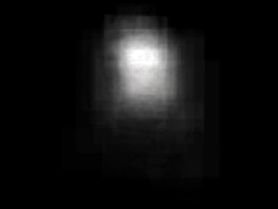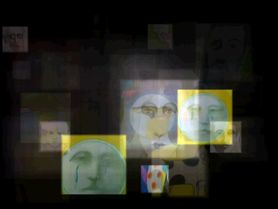Film Faceprints
(implemented and shown below) Run face detection on film frames, grabbing full-size frames in which non-face areas are masked off. Average these frames together to generate a single-frame representation of presence and characters over the duration of the film. This leaves you with a kind of thumbprint of the film and it’s characters. The results are kind of anticlimactic, there are only vague shadows of faces. A failed experiment, but brings to mind some more interesting directions of approach to the content.
(Animating the accumulation of the average, scaling all of the faces to the same dimension before averaging — or maybe ditching the averaging idea and trying a grid arrangement that would reduce a film’s narrative to a series of faces.)

Titicut Follies is at top. Bottom left is an excerpt from a film about Abraham Lincoln, bottom right is Yellow Submarine.
Perhaps more interesting are the algorithms leftovers. As it runs, the latest faces are dumped into a buffer and drawn to the screen. A couple averages in progress are shown below:
Here is the rather messy source code.
Quantify Contact
Run face detection on the contents of your computer screen. Log how often faces are encountered in web browsing / photo editing / whatever. In this way the relative loneliness of extended sessions in front of a machine could be quantified.
Curb Paranoia
Implement a face-detecting and obfuscating filter at a very low level (somewhere in the camera driver, probably). Pseudo-privacy protection
Quantifibate
Run face detection on your laptop’s camera all the time. Since computers tend to be left on, “uptime” doesn’t say much about the hours per day sunk into these machines. Face detection could give more accurate statistics about presence / attention.
Tenso
Automate the face swapping / tenso meme.
Almost Face
Go through large sets of face-tagged images (an iPhoto library, for example) and hand-pick all of the false positives to build a collection of almost-faces.
Street View
Process Google Street View panoramas for faces. Hit rate might be a bit low since google blurs faces, but it would be interesting to build a map of geolocated faces.



